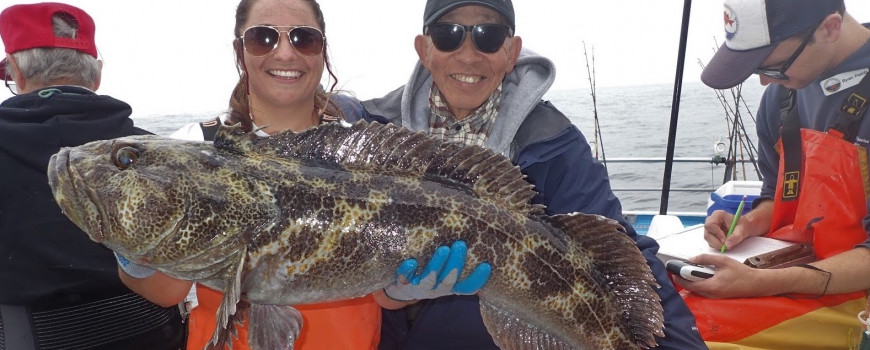Over the last two decades, California created a unique network of marine protected areas across the state with the intention of cultivating healthy ocean ecosystems. But because the act limited fishing and other activities in certain areas, it was met with skepticism by many recreational anglers.
“Historically, there’s been a sensitive or delicate relationship between resource users and resource managers,” says Rick Starr, a fisheries and ecology researcher from San Jose State University’s Moss Landing Marine Laboratories, and previous director of the California Sea Grant Extension Program. “There’s not always been complete trust between the two groups.”
To improve the relationship and encourage discussion between sport anglers and resource managers, Starr and his Cal Poly San Luis Obispo colleague, Dean Wendt, created the California Collaborative Fisheries Research Program (CCFRP) through California Sea Grant in 2007.
The program invites academic scientists, industry professionals and recreational anglers to work together monitoring offshore marine protected areas (MPAs). The data that the groups collect influence ocean protection policy decisions, and many of the anglers involved come away from the experience with more positive views of MPAs.
“Our feeling was — and still is — that as the people who are affected by regulations are on the ocean, talking and collecting the data with scientists, we would reach a shared understanding of the status of the resource,” says Starr.
Starr and Wendt traveled up and down the coast for a year, talking with port managers, tackle stores, fishing businesses, sport anglers and California Department of Fish and Wildlife and National Marine Fisheries Service scientists. They used the input to design a program that enables recreational anglers to work beside scientists collecting information about the state of California’s fisheries.
The program started in central California with Moss Landing Marine Laboratories and Cal Poly San Luis Obispo, but has grown to include six research institutions ranging from Humboldt to San Diego. Each institution charters boats and takes volunteer anglers and scientists to fish in areas inside and outside of protected areas.
A CCFRP team member measures a rockfish. Photograph from Rachel Brooks
The groups fish using a standardized method and record data such as size, species and location for each fish. They also tag a subset of the fish before releasing or descending them, which allows scientists to track movements of fishes over several years.
In 2019, the program became part of a larger California Ocean Protection Council, California Sea Grant, and California Department of Fish and Wildlife jointly-funded Marine Protected Area Monitoring Program that aims to assess how protected areas impact marine ecosystems and communities across California.
Tackling local relationships
CCFRP’s dependence on recreational experts makes it unique among monitoring projects. The program sends out newsletters to keep anglers updated, and at the end of each year the partnering institutions host angler appreciation events. Organizers highlight the most unusual catches and statistics for the year, and sport anglers and scientists discuss the data together.
The catch summaries and the personal experiences fishing inside and outside MPAs also change the way some anglers think about protected areas. “A recent publication by Erica Mason and members of our CCFRP team show that people participating in the program develop more positive attitudes towards MPAs,” says Scott Hamilton, a Moss Landing scientist who co-directs the program. “The angling community is one of the most important stakeholder groups and coastal users, so having them involved is critical.”
Across the state, more than 1,600 sport anglers have volunteered with CCFRP. Many of the anglers who start volunteering with the program continue for multiple years and introduce new anglers to the group.
“Forming those relationships and hearing their fishing stories and their experiences and their perspective on CCFRP is my favorite part of working on this project,” says Rachel Brooks, a graduate student at Moss Landing Marine Laboratories and the statewide coordinator for CCFRP.
The program also welcomes resource managers to board the boats and talk with the anglers and scientists. Starr says he doesn’t expect these conversations to solve all fisheries management disputes, but he hopes it will bring stakeholders and managers to a consensus surrounding the underlying facts.
“There may be disagreements over policy,” he says. “But there shouldn’t be any disagreements about the information that’s used to come to that policy.”
The teams fish between kelp forests and deep water. Photograph from Rachel Brooks
Because of where the anglers fish, the data the program collects is especially valuable for informing MPA policy. “A lot of fish that live off the coast grow up in kelp forests and then move to deeper waters as they grow,” says Starr. “We’re right in the area with the greatest fishing stress — just outside the kelp forests before deep water.”
Scientists say it’s still too early to see a statewide trend for how MPAs impact fisheries, but results from 13 years of data collection on the Central Coast look promising. “We’re starting to see some really clear effects of protection on many of the fish populations,” says Hamilton. “We didn’t think we’d start to see that for quite a long time.”
This year proved particularly challenging with the pandemic, but the program managed to take out anglers and collect enough data for the season. “COVID definitely added some hurdles,” says Brooks. “We set up our own CCFRP sampling guidelines, but each of the six institutions had to get their own approval through their university to be able to sample.”
CCFRP’s organizers expect the program to continue long after the current three-year grant ends. “There’s incredible value in the data being generated, both for evaluating performance of the marine reserve network and for fisheries management and stock assessments,” says Hamilton “I hope that we can continue and reach out even more broadly to the angling community.”
Written by Erin Malsbury, California Sea Grant/UC Santa Cruz Science Writing Intern 2020

